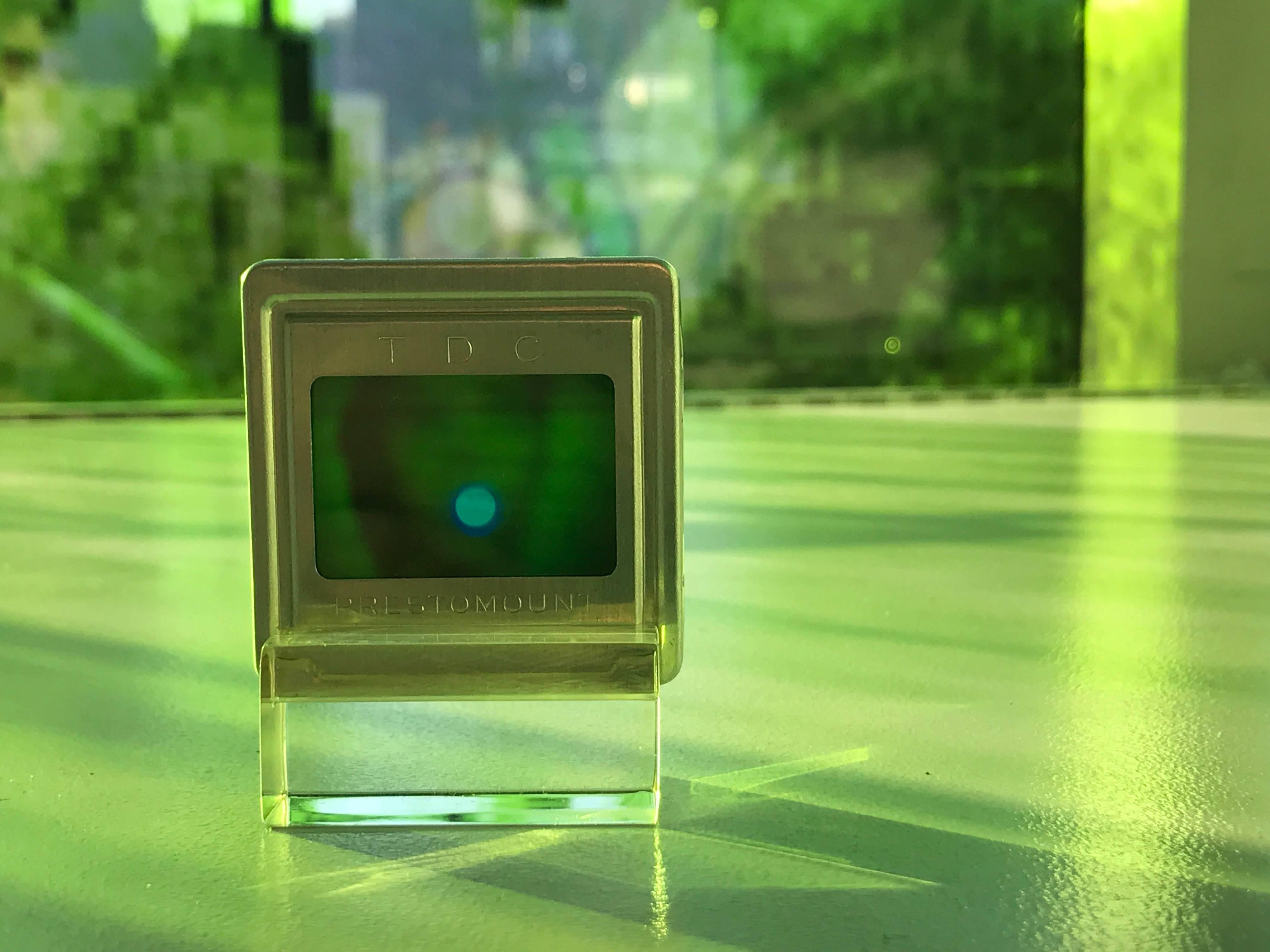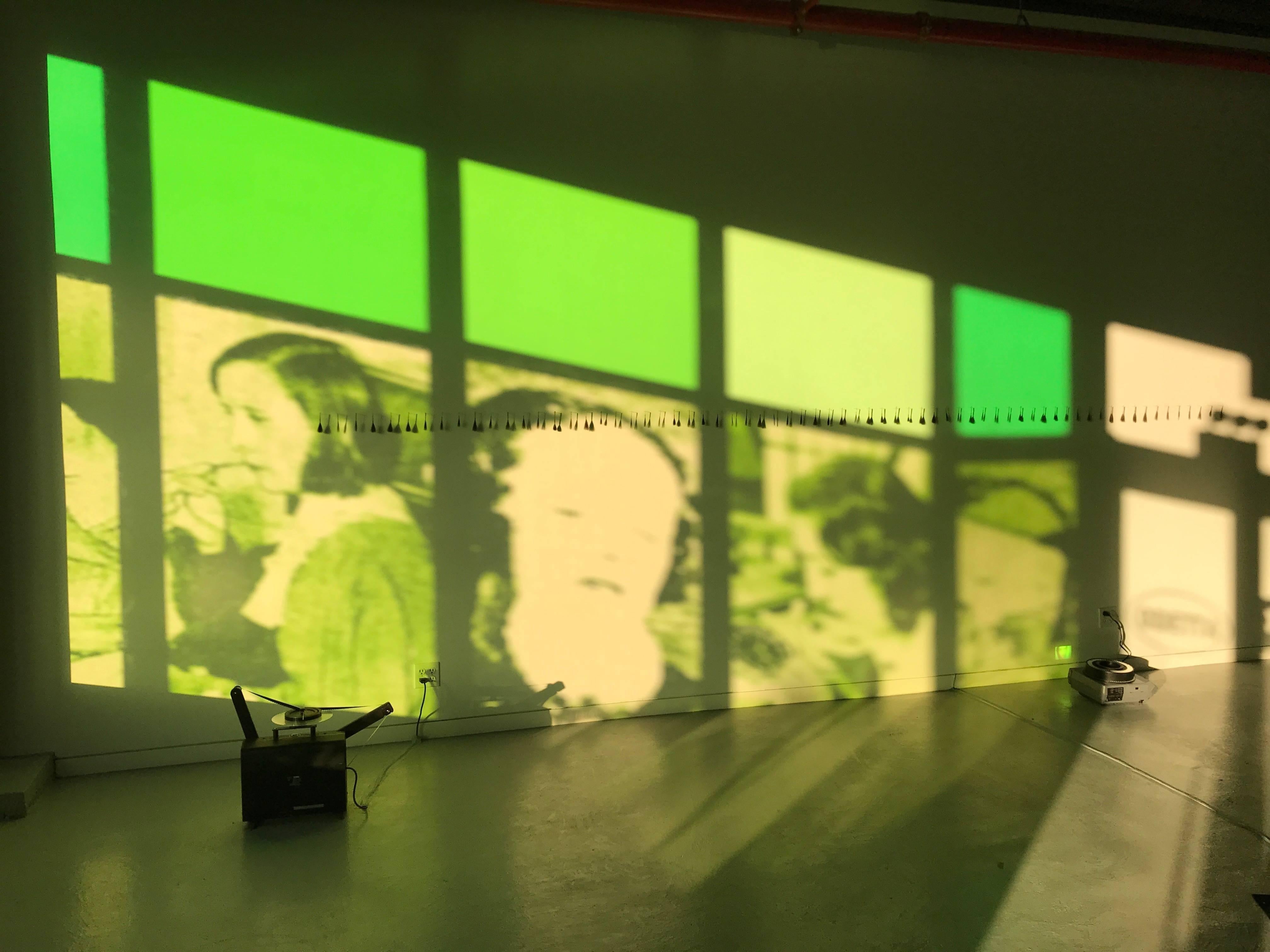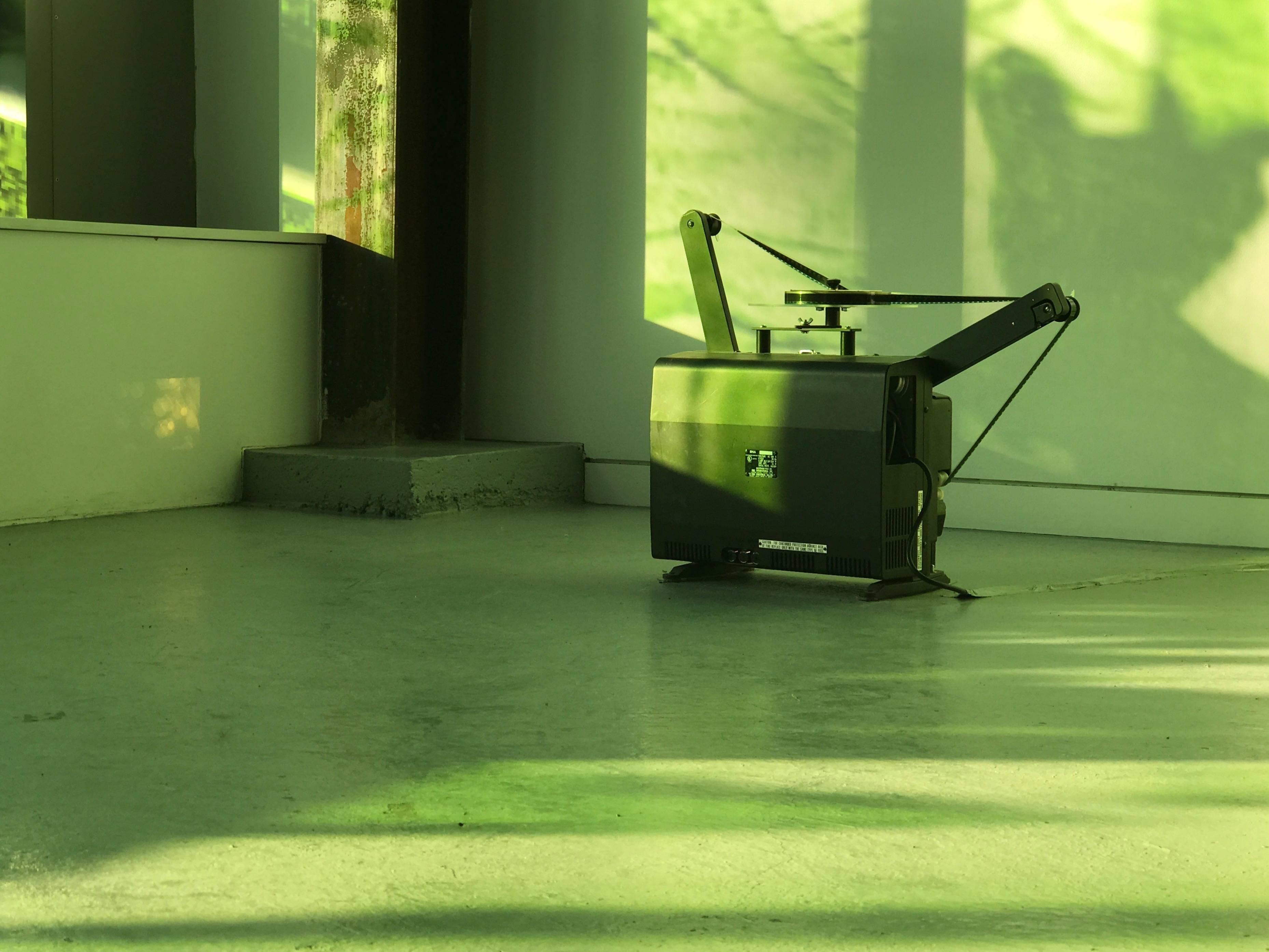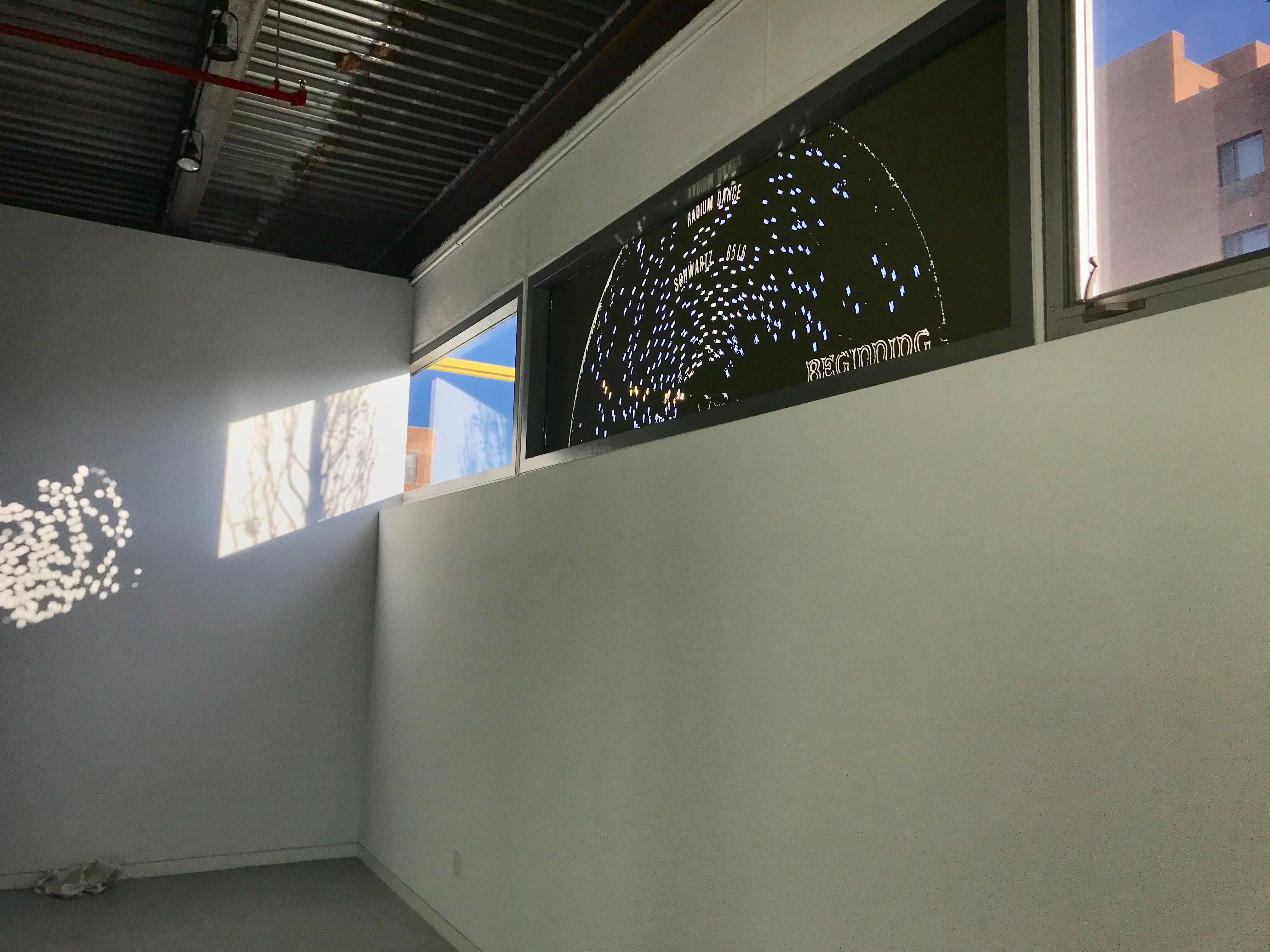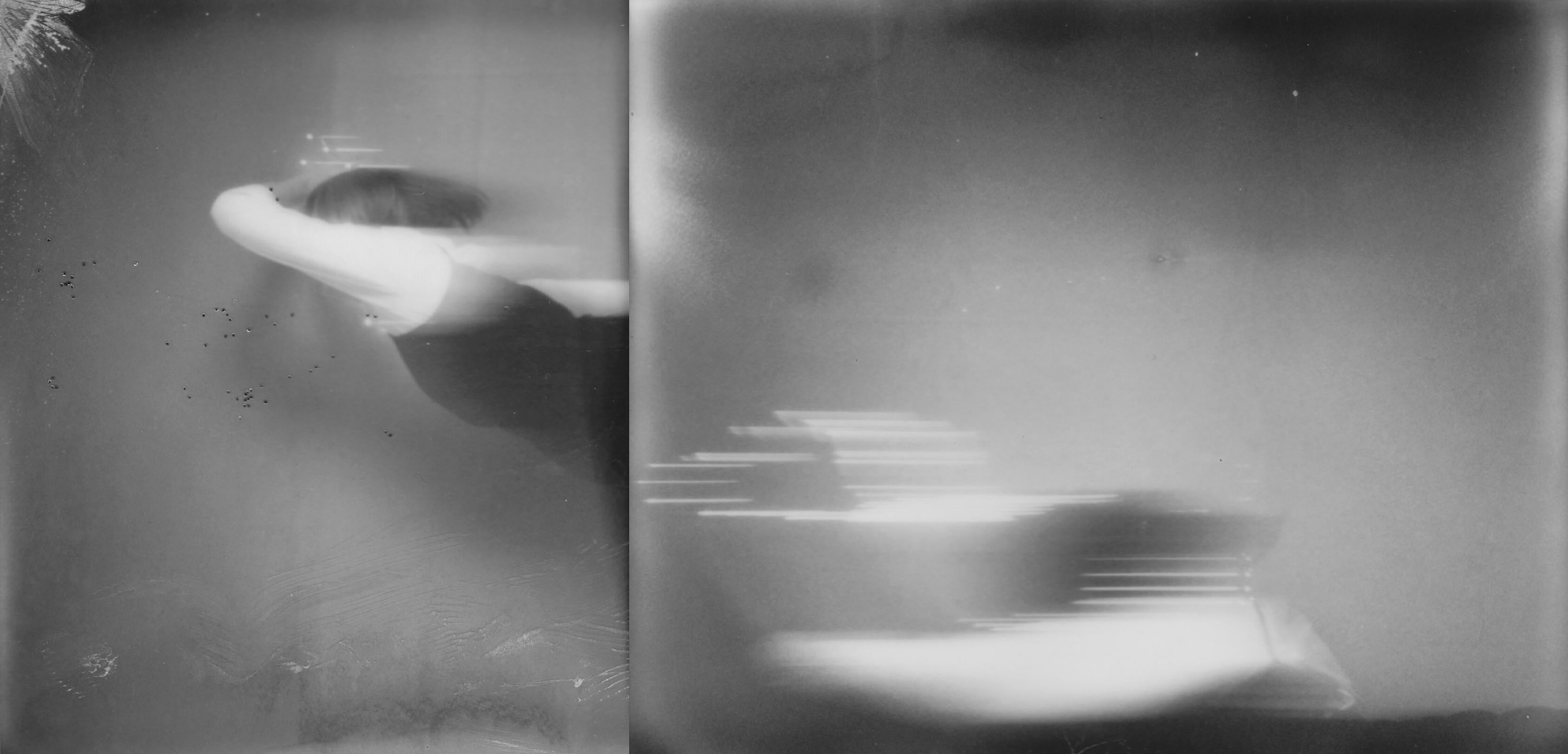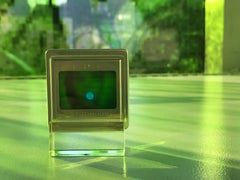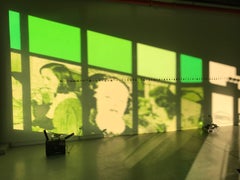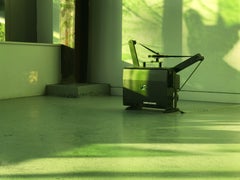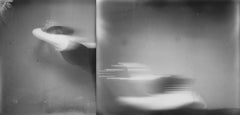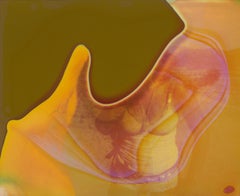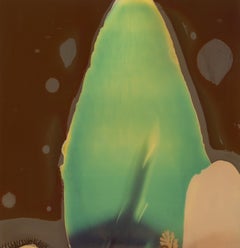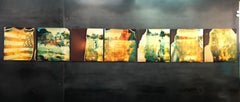Items Similar to Jo Yarrington, Ghost girls_Slide Carousel, 2018, Photographic Film, Found Object
Want more images or videos?
Request additional images or videos from the seller
1 of 4
Jo YarringtonJo Yarrington, Ghost girls_Slide Carousel, 2018, Photographic Film, Found Object2018
2018
$5,500
£4,156.94
€4,791.03
CA$7,760.50
A$8,552.61
CHF 4,477.58
MX$105,053.11
NOK 56,261.73
SEK 52,656.50
DKK 35,771.80
About the Item
Radioluminescence is the phenomenon by which light is produced in a material by bombardment with ionizing radiation and can be used as a low-level light source for night illumination of instruments or signage or other applications where light must be produced for long periods without external energy sources. Radioluminescent paint used to be used for clock hands and instrument dials, enabling them to be read in the dark.
What is now referred to as the Radium Girls, or Ghost Girls were female factory workers who contracted radiation poisoning from painting watch dials with self-luminous paint. The painting was done by women at three different factory sites in the United States, and the term now applies to the women who worked at these facilities. The first, United States Radium factory in Orange, New Jersey, beginning around 1917, the second, at Ottawa, Illinois, beginning in the early 1920s, and the third facility at Timex in Waterbury, Connecticut. The politics surrounding this issue which resulted in a groundbreaking battle for workers’ rights and specifically for women’s rights in the workplace has been both heartbreaking and inspiring. Their story especially resonates with Yarrington's expanding interest in Uranium as an element, and its many properties and functions, from its emanation of light wave particles to its inherent power to both sustain life and to take it away.
Returning for a second major site-specific installation at ODETTA, Jo Yarrington’s drawings, photographs, and architecturally-based installations have been shown at the Aldrich Contemporary Art Museum, CT, Yale University, the Rotunda Gallery, Brooklyn, the Museum of Glass, WA, Chashama/ Sited at the Donnell 20 W. 53rd, NY, the Contemporary Jewish Museum, San Francisco, CA, Trinity Museum, NY, DeCordova Museum and Sculpture Park, MA, Artists Space, NY, Artspace, CT, Grounds for Sculpture, NJ, and the William Benton Museum of Art, CT.
2016 exhibitions include Heliotrope at ODETTA, Brooklyn, NY, Edition Tools at the Project Space Gallery, SUNY at Oneonta and a solo Containment and Spillage Series, a collaborative exhibition at the Humanities Gallery, Long Island University Brooklyn.
International exhibitions have included Galeria Sala Uno, Italy, Centro de las Artes de Guanajuato, Mexico, Christuskirche, Germany, Glasgow School of Art, Scotland.
Yarrington is a recipient of fellowships from the Pollock Krasner Foundation, the New York Foundation for the Arts, the Joan Mitchell Foundation, Cill Rialaig Artists Residency/Ireland, the MacDowell Colony, SIMS Residency/ Iceland, Ucross Residency/Wyoming, the American Scandinavian Foundation,, the Leighton Artist Colony, Banff, Alberta Canada, the Brandywine Institute, the Pennsylvania Council for the Arts, New York Foundation for the Arts and the Connecticut Commission on Culture and Tourism.
Jo Yarrington is a Professor of Studio Art in the Department of Visual and Performing Arts at Fairfield University in Fairfield, CT. She lives and works in New York City.
- Creator:
- Creation Year:2018
- Dimensions:Height: 7 in (17.78 cm)Width: 11 in (27.94 cm)Depth: 13 in (33.02 cm)
- Medium:
- Movement & Style:
- Period:
- Condition:This sculptural installation includes a vintage slide projector with the full carousel of Ghost Girls 35mm slides. These images are not available on a flash drive or to be downloaded as a file.
- Gallery Location:Darien, CT
- Reference Number:1stDibs: LU17222473021
About the Seller
5.0
Vetted Professional Seller
Every seller passes strict standards for authenticity and reliability
Established in 2014
1stDibs seller since 2015
144 sales on 1stDibs
- ShippingRetrieving quote...Shipping from: Darien, CT
- Return Policy
Authenticity Guarantee
In the unlikely event there’s an issue with an item’s authenticity, contact us within 1 year for a full refund. DetailsMoney-Back Guarantee
If your item is not as described, is damaged in transit, or does not arrive, contact us within 7 days for a full refund. Details24-Hour Cancellation
You have a 24-hour grace period in which to reconsider your purchase, with no questions asked.Vetted Professional Sellers
Our world-class sellers must adhere to strict standards for service and quality, maintaining the integrity of our listings.Price-Match Guarantee
If you find that a seller listed the same item for a lower price elsewhere, we’ll match it.Trusted Global Delivery
Our best-in-class carrier network provides specialized shipping options worldwide, including custom delivery.More From This Seller
View AllJo Yarrington, Ghost Girls Slides for Carousel, Photographic Film, Plastic
By Jo Yarrington
Located in Darien, CT
Radioluminescence is the phenomenon by which light is produced in a material by bombardment with ionizing radiation and can be used as a low-level light source for night illumination of instruments or signage or other applications where light must be produced for long periods without external energy sources. Radioluminescent paint used to be used for clock hands and instrument dials...
Category
2010s Conceptual Still-life Sculptures
Materials
Metal
Jo Yarrington, Ghost Girls 2018, Digital Print, Plastic
By Jo Yarrington
Located in Darien, CT
This series of six transparencies are in an edition size of 3. They are designed to be installed directly onto interior window areas to allow light to pass thru them. These transparencies can also be purchased separately for $3200 each and are an edition size of 3. Dimensions are 72 x 48 inches each. The upper transoms are window transparencies in shades of green. They are also available and can be fit to meet specific window sizes. In this window setting, they are 45 x 45 inches and can be purchased as a set of 5 panels for $3500 for that group.
Radioluminescence is the phenomenon by which light is produced in a material by bombardment with ionizing radiation and can be used as a low-level light source for night illumination of instruments or signage or other applications where light must be produced for long periods without external energy sources. Radioluminescent paint used to be used for clock hands and instrument dials...
Category
2010s Conceptual Portrait Photography
Materials
Plastic, Digital
Jo Yarrington, Ghost Girls Film and Vintage Projector, 2018, Film, Found Objects
By Jo Yarrington
Located in Darien, CT
This installation imagines the Radium Girls as abstractd subjects. Repeating a motif of a circle, signifying the mouth, this art object conveys a modern view of the these workers, tied in with repetitive actions in abstracted patterns.
Radioluminescence is the phenomenon by which light is produced in a material by bombardment with ionizing radiation and can be used as a low-level light source for night illumination of instrument...
Category
2010s Conceptual Portrait Photography
Materials
Film, Found Objects
Jo Yarrington, Ghost Girls, 2018, Organic Material, Photographic Film, Plastic
By Jo Yarrington
Located in Darien, CT
Radioluminescence is the phenomenon by which light is produced in a material by bombardment with ionizing radiation and can be used as a low-level light source for night illumination of instruments or signage or other applications where light must be produced for long periods without external energy sources. Radioluminescent paint used to be used for clock hands and instrument dials...
Category
2010s Conceptual Abstract Sculptures
Materials
Pins, Organic Material, Plastic, Photographic Film, Acrylic Polymer, Fou...
Jo Yarrington, Ghost Girls_ The Radium Dance, 2018, Paper, Inkjet Print
By Jo Yarrington
Located in Darien, CT
Radioluminescence is the phenomenon by which light is produced in a material by bombardment with ionizing radiation and can be used as a low-level light source for night illumination of instruments or signage or other applications where light must be produced for long periods without external energy sources. Radioluminescent paint used to be used for clock hands and instrument dials...
Category
2010s Conceptual More Prints
Materials
Paper, Inkjet
Jo Yarrington, Ghost Girls_Transparencies, 2017, Inkjet Print, Photographic Film
By Jo Yarrington
Located in Darien, CT
Radioluminescence is the phenomenon by which light is produced in a material by bombardment with ionizing radiation and can be used as a low-level light source for night illumination of instruments or signage or other applications where light must be produced for long periods without external energy sources. Radioluminescent paint used to be used for clock hands and instrument dials...
Category
2010s Conceptual Portrait Photography
Materials
Plastic, Photographic Film, Inkjet
You May Also Like
Ghost Story - Contemporary, Figurative, Woman, Polaroid, Photograph, 21st Centur
By Lisa Toboz
Located in Morongo Valley, CA
Ghost Story - 2021 - diptych
Archival C-Print based on an original Polaroid on Hahnemuhle photo rag paper.
Edition of 10 plus 2 Artist Proofs.
Signature label and certificate.
No...
Category
2010s Contemporary Color Photography
Materials
Archival Ink, Archival Paper, Color, Archival Pigment, Polaroid
Living in a Dream (Till Death do us Part) - Contemporary, Polaroid, Women
By Stefanie Schneider
Located in Morongo Valley, CA
Living in a Dream (Till Death do us Part) - 2005
20x20cm,
Edition of 10,
Archival C-Print print, based on the Polaroid.
Certificate and Signature label, artist Inventory No. 9781.
Not mounted.
on offer is a piece from the movie "Till Death do us Part"
Stefanie Schneider’s Till Death Do Us Part
or “There is Only the Desert for You.”
BY DREW HAMMOND
Stefanie Schneider’s Til Death to Us Part is a love narrative that comprises three elements:
1.
A montage of still images shot and elaborated by means of her signature technique of using Polaroid formats with outdated and degraded film stock in natural light, with the resulting im ages rephotographed (by other means) enlarged and printed in such a way as to generate further distortions of the image.
2.
Dated Super 8 film footage without a sound track and developed by the artist.
3.
Recorded off-screen narration of texts written by the actors or photographic subjects, and selected by the artist.
At the outset, this method presupposes a tension between still and moving image; between the conventions about the juxtaposition of such images in a moving image presentation; and, and a further tension between the work’s juxtaposition of sound and image, and the conventional relationship between sound and image that occurs in the majority of films. But Till Death Do Us Part also conduces to an implied synthesis of still and moving image by the manner in which the artist edits or cuts the work.
First, she imposes a rigorous criterion of selection, whether to render a section as a still or moving image. The predominance of still images is neither an arbitrary residue of her background as a still photographer—in fact she has years of background in film projects; nor is it a capricious reaction against moving picture convention that demands more moving images than stills. Instead, the number of still images has a direct thematic relation to the fabric of the love story in the following sense. Stills, by definition, have a very different relationship to time than do moving images. The unedited moving shot occurs in real time, and the edited moving shot, despite its artificial rendering of time, all too 2009often affords the viewer an even greater illusion of experiencing reality as it unfolds. It is self-evident that moving images overtly mimic the temporal dynamic of reality.
Frozen in time—at least overtly—still photographic images pose a radical tension with real time. This tension is all the more heightened by their “real” content, by the recording aspect of their constitution. But precisely because they seem to suspend time, they more naturally evoke a sense of the past and of its inherent nostalgia. In this way, they are often more readily evocative of other states of experience of the real, if we properly include in the real our own experience of the past through memory, and its inherent emotions.
This attribute of stills is the real criterion of their selection in Til Death Do Us Part where consistently, the artist associates them with desire, dream, memory, passion, and the ensemble of mental states that accompany a love relationship in its nascent, mature, and declining aspects.
A SYNTHESIS OF MOVING AND STILL IMAGES BOTH FORMAL AND CONCEPTUAL
It is noteworthy that, after a transition from a still image to a moving image, as soon as the viewer expects the movement to continue, there is a “logical” cut that we expect to result in another moving image, not only because of its mise en scène, but also because of its implicit respect of traditional rules of film editing, its planarity, its sight line, its treatment of 3D space—all these lead us to expect that the successive shot, as it is revealed, is bound to be another moving image. But contrary to our expectation, and in delayed reaction, we are startled to find that it is another still image.
One effect of this technique is to reinforce the tension between still and moving image by means of surprise. But in another sense, the technique reminds us that, in film, the moving image is also a succession of stills that only generate an illusion of movement. Although it is a fact that here the artist employs Super 8 footage, in principle, even were the moving images shot with video, the fact would remain since video images are all reducible to a series of discrete still images no matter how “seamless” the transitions between them.
Yet a third effect of the technique has to do with its temporal implication. Often art aspires to conflate or otherwise distort time. Here, instead, the juxtaposition poses a tension between two times: the “real time” of the moving image that is by definition associated with reality in its temporal aspect; and the “frozen time” of the still image associated with an altered sense of time in memory and fantasy of the object of desire—not to mention the unreal time of the sense of the monopolization of the gaze conventionally attributed to the photographic medium, but which here is associated as much with the yearning narrator as it is with the viewer.
In this way, the work establishes and juxtaposes two times for two levels of consciousness, both for the narrator of the story and, implicitly, for the viewer:
A) the immediate experience of reality, and
B) the background of reflective effects of reality, such as dream, memory, fantasy, and their inherent compounding of past and present emotions.
In addition, the piece advances in the direction of a Gesammtkunstwerk, but in a way that reconsiders this synaesthesia as a unified complex of genres—not only because it uses new media that did not exist when the idea was first enunciated in Wagner’s time, but also because it comprises elements that are not entirely of one artist’s making, but which are subsumed by the work overall. The totality remains the vision of one artist.
In this sense, Till Death Do Us Part reveals a further tension between the central intelligence of the artist and the products of other individual participants. This tension is compounded to the degree that the characters’ attributes and narrated statements are part fiction and part reality, part themselves, and part their characters. But Stefanie Schneider is the one who assembles, organizes, and selects them all.
THE RELATIONSHIP BETWEEN THIS IDEA (above) AND PHOTOGRAPHY
This selective aspect of the work is an expansion of idea of the act of photography in which the artistic photographer selects that which is already there, and then, by distortion, definition or delimitation, compositional and lighting emphasis, and by a host of other techniques, subsumes that which is already there to transform it into an image of the artist’s contrivance, one that is no less of the artist’s making than a work in any other medium, but which is distinct from many traditional media (such as painting) in that it retains an evocation of the tension between what is already there and what is of the artist’s making. Should it fail to achieve this, it remains, to that degree, mere illustration to which aesthetic technique has been applied with greater or lesser skill.
The way Til Death Do Us Part expands this basic principle of the photographic act, is to apply it to further existing elements, and, similarly, to transform them. These additional existing elements include written or improvised pieces narrated by their authors in a way that shifts between their own identities and the identities of fictional characters. Such characters derive partially from their own identities by making use of real or imagined memories, dreams, fears of the future, genuine impressions, and emotional responses to unexpected or even banal events. There is also music, with voice and instrumental accompaniment. The music slips between integration with the narrative voices and disjunction, between consistency and tension. At times it would direct the mood, and at other times it would disrupt.
Despite that much of this material is made by others, it becomes, like the reality that is the raw material of an art photo, subsumed and transformed by the overall aesthetic act of the manner of its selection, distortion, organization, duration, and emotional effect.
* * *
David Lean was fond of saying that a love story is most effective in a squalid visual environment. In Til Death Do Us Part, the squalor of the American desert...
Category
Early 2000s Contemporary Color Photography
Materials
Archival Paper, Photographic Paper, C Print, Color, Polaroid
Plane Mirage (Stranger than Paradise)
By Stefanie Schneider
Located in Morongo Valley, CA
Plane Mirage - 2008
40x40cm,
Edition of 10, plus 2 Artist Proofs.
Archival C-Print, based on the Polaroid.
Signature label and Certificate.
Artist Inventory #4645.
Not mounted...
Category
Early 2000s Contemporary Color Photography
Materials
Archival Paper, Photographic Paper, C Print, Color, Polaroid
Memorial Day (Stranger than Paradise) - analog, mounted, 7 pieces, 48x352cm
By Stefanie Schneider
Located in Morongo Valley, CA
Memorial Day (Stranger than Paradise) - 2001
Edition of 5,
48x46 cm each, installed 48 x 352cm including gaps.
7 analog C-Prints, hand-printed by the artist on Fuji Crystal Archiv...
Category
Early 2000s Contemporary Color Photography
Materials
Metal
Vacancy - Contemporary, Polaroid, Color, 21st Century
By Lisa Toboz
Located in Morongo Valley, CA
Vacancy, 2019,
Edition 1/10 plus 2 Artist Proof, 20x20cm.
Digital C-Print based on a mixed-media collage of an original Polaroid on Hahnemuhle photo rag paper.
Signature label and ...
Category
2010s Contemporary Color Photography
Materials
Archival Ink, Archival Paper, Color, Archival Pigment, Polaroid
Strangers (Deconstructivism) - 21st Century, Polaroid, Color
By Stefanie Schneider
Located in Morongo Valley, CA
Strangers (Deconstructive) - 2022
Edition of 10,
49x48cm.
Archival C-Print, based on the Polaroid.
Artist inventory number: 18894.
Signature label and certificate.
Not mounted. ...
Category
Early 2000s Contemporary Color Photography
Materials
Archival Paper, Photographic Paper, C Print, Color, Polaroid
More Ways To Browse
Instrument Dial
Glasgow Girls
Ghost Watch
Timex Waterbury
Mexican Carousel
George Alexander
Matisse Collage
Modernist Poster
Grace Jones
Medical Sculpture
Mexican Etching
Salvador Dali 1989
Original Signed Picasso Etching
Woodcuts Signed
Female Torso
Joan Miro Barcelona Lithograph
Etchings Of Churches
Historical Monuments
